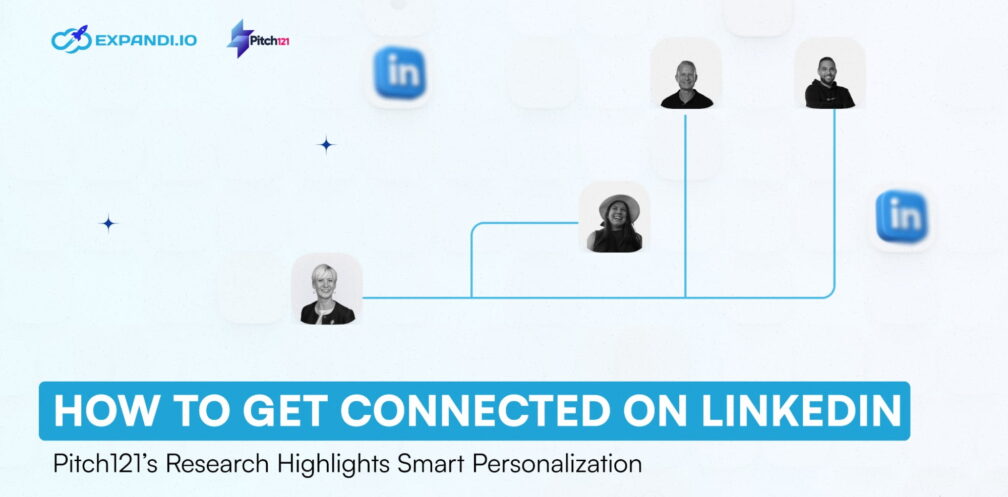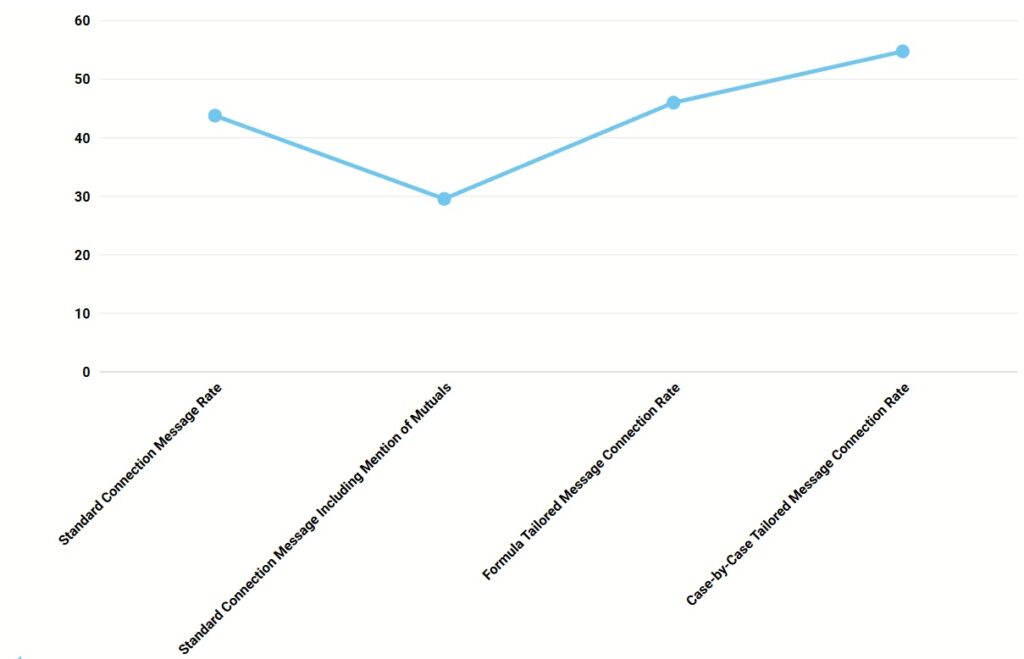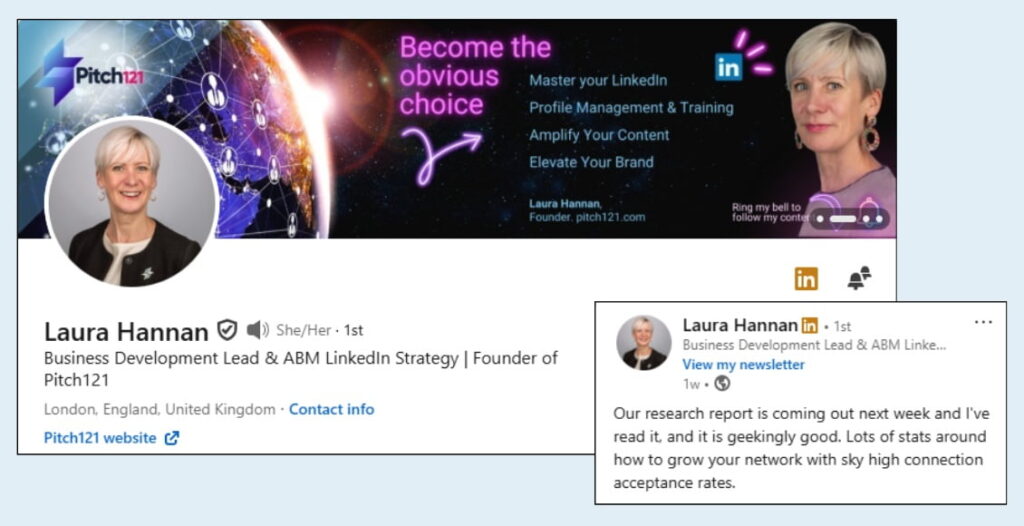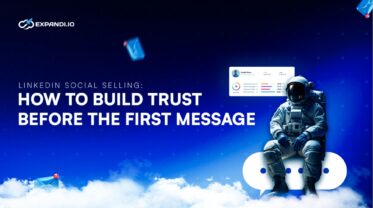How To Get Connected On LinkedIn: Pitch121’s Research Highlights Smart Personalization

Ever wait for ages for reliable benchmarks to be published about LinkedIn outreach, and then what do you know? Two come along in quick succession! (Probably not, but we can hope!)
In April, Expandi released “The State of LinkedIn Outreach: Q1 2025” on this very site. And now, our team at Pitch121 are following it up with a new report “Get Connected (On LinkedIn)”, where we cover what kinds of connection requests people like to receive, levels of personalization, using ABM strategies, and more. As a bonus, we also incorporated Expandi’s anonymized user data into our analysis.
It’s obvious why people want to know more about LinkedIn outreach success rates:
- B2B sales is getting harder, with more stakeholders having a say leading to longer sales cycles.
- Email – the long-dominant channel for B2B – is becoming less effective. The average cold email response rate is just 5.1%.
- LinkedIn use is exploding. User numbers rose from 644 million in 2019 to 1.15 billion in early 2025.
But it’s all too easy to get LinkedIn outreach wrong, and you might be surprised at some of the factors that our new report found could sink your efforts or make them soar.
A bit about us: Pitch121 is a LinkedIn lead nurturing agency that has been helping companies become the obvious choice for their clients since 2018, so they have plenty of data to draw on. I spoke with Pitch121’s founder Laura Hannan, to find out more.
Key Takeaways
- Adding a message to your connection requests on LinkedIn doesn’t matter that much. In our data, the difference between approval rates for requests sent with and without messages was only 0.05-1.28%.
- Shallow personalization of connection requests makes them perform worse than no personalization at all. If you only reference mutual connections, the connection acceptance rate drops by 10%.
- Having a sales job title puts people off (25.81% acceptance rate), while descriptive profile headlines that include mentions of your expertise, who you help, and a mission statement improve performance even with a blank connection request (29.58% acceptance rate).
No Message Can Be as Good as an Average Message
One of the questions Laura is most often asked is this: “how important is it to pay for my LinkedIn membership?”
In 2023, around 17.7% of users had paid-for accounts of one sort or another. Since then, LinkedIn cracked down on what free users were able to do:
- Bespoke messages can only be sent with connection requests between 5 and 20 times per month
- The maximum length of those messages was cut from 300 to 200 characters
- Analytics data available to free users have also been restricted
A lot of users worry that without the ability to send tailored messages, their LinkedIn outreach will blend into the background noise.
But when Pitch121 polled hundreds of active LinkedIn users on this question, the results were surprising:

And then a series of A/B tests carried out between February and May 2025 bore that out very clearly. The difference between approval rates for requests sent with and without messages was just 1.28%:

We found something very similar in Expandi’s data. Across more than 170,000 campaigns analysed, the difference was just 0.05% in favour of requests with messages!
Confusing huh? All the experts tell us that successful outreach depends on personalization. How can a connection request with no message be personal?
“If you just want to build your network indiscriminately, the data tells us that you don’t need to worry about your free LinkedIn account preventing you from sending bespoke messages when you connect,” explains Hannan. “But if you want to connect with specific people or generate conversations, you need to be doing personalizing – and I mean real personalization, not bad personalization.”
But what’s bad personalization? And what’s real personalization?
Avoid Generic – Embrace Individual Messaging
We’ve all had those “Dear [FirstName]” emails… Does anyone still really believe that templated messages like that are “personalized” in a meaningful sense?
But today’s busy sales reps don’t have time to do in-depth research on every prospect from target accounts – especially as buying committees continue to get bigger.
So is there a sweet spot?
Pitch121 tested four different levels of personalization over hundreds of connection requests sent:
- A template introduction message, varying only the FirstName field
- A slightly more tailored message, including the First Name and mentioning mutual connections – by name if three or fewer
- A message tailored to a consistent formula, referencing recent posts, employment and/or education in common, mutual connections, and/or outstanding profile features
- A genuinely personalised, completely bespoke message – crafted by digging into the prospect’s profile looking for talking points, things the profile had in common with them, activities that the profile had recently been involved in, and reasons why the profile would be looking to connect with the prospect
The results were as follows:

- Type 2 messages performed worse (29.56%) than Type 1 (40.41%). Simply mentioning mutual connections without regard to whether the prospect really knows them actually made people less likely to connect.
- Type 3 messages scored slightly better than Type 1 (46%).
- But Type 4 messages – those which were crafted on a genuinely person-by-person basis – outperformed all others, with a connection rate of 54.76%.
“Minimal personalization (e.g. simply mentioning mutual connections) turns out to be worse than no personalization,” warns Hannan. “But once you’ve actually found something meaningful to point out, more effort yields better results.”
Put The Work Into Your Messages, Your Profile, Or Both
It’s clear that (other things being equal) the more you can say in your message that creates rapport, a sense of interests in common, intrigue, and the general sense that you’d be a valuable person to have as a connection, the better your chances of a positive response.
But the more effort you pour into researching those things, the fewer messages you’ll actually manage to send out! What if you need to make a lot of new connections in a hurry?
Our data suggests that the most efficient approach here is:
- Send connection requests with no message.
- This will drive recipients to view your profile page to see who you are.
- Impress them with an awesome profile that makes them want to connect with you!
But what data has the biggest impact on profile viewers? It’s your headline – which is displayed whenever you send a connection request, appear in a news feed, or when someone lands on your profile page. .

We found that if you have a high-level, non-sales job title, a Headline composed just of your title and your company outperforms the norm. But if you have a sales job title – no matter how senior – it’ll put people off.
Using the same types of connection request message across the board, A/B tests yielded the following approval rates:

Where a “Descriptive” headline is one that includes elements like:
- How you help and who you help
- An expertise
- A “mission statement”
- Searchable keywords
Hannan explained: “We carried out more tests to see if this ‘sales penalty’ applied when sending blank connection requests.And we found that it did. Even more so.”

Takeaways
There are a lot more insights in “Get Connected (On LinkedIn)” and we’d encourage you to read it in full.
But if you’re looking for just the takeaways from this preview, here they are:
- Connection requests with no message perform almost as well as requests with templated messages.
- Lazy message personalization is worse than no personalization, so avoid the “Dear [FirstName]” trap”!
- LinkedIn users don’t really know most of the people in their networks, so be wary of mentioning mutual connections without context.
- The more effect you put into personalizing connection messages, the more likely they are to be successful.
- Requests without messages drive recipients to view your profile, so make sure you optimize your Headline – while avoiding the “sales penalty”.
You’ve made it all the way down here, take the final step



